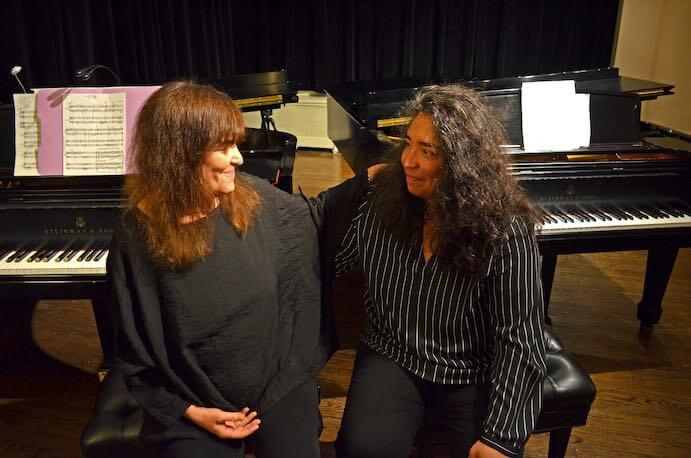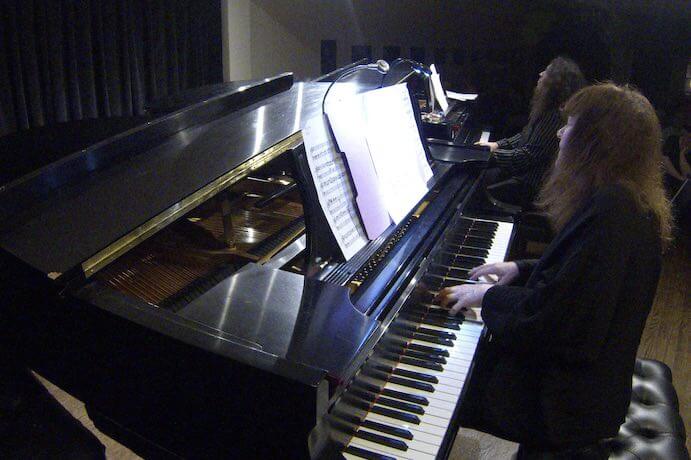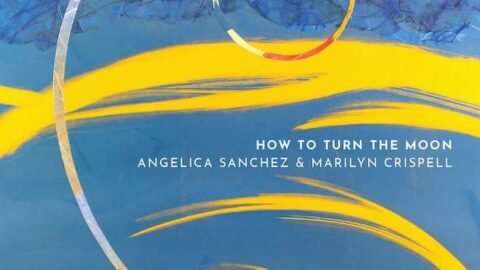How to Turn the Moon is a new collection of improvisations and cellular compositions by New York-based pianist, composer, and educator Angelica Sanchez featuring Woodstock, NY-based performer and improviser Marilyn Crispell. Scheduled for release on October 2, 2020 on Pyroclastic Records, the album is a somewhat routine exhibition of improvisatory techniques spread across two pianos, greatly enhanced by the striking individuality and expertise that Sanchez and Crispell each bring to the table.
Described in the liner notes as Sanchez’s creative colleague and mentor, Crispell’s mastery of free improvisation places her alongside artists such as Anthony Braxton and Reggie Workman with whom she has performed for over a decade. Likewise, Sanchez has collaborated with a host of notable artists of her generation including 2017 MacArthur Fellow Tyshawn Sorey.
Though Sanchez first heard Crispell perform at just 16-years-old (by way of a recording), the duo met only a few years ago at Karl Berger’s Creative Music Studio Workshop in Woodstock, where their friendship quickly flourished. It is beautiful to see a collaboration like How to Turn the Moon bloom from such a seed and illuminate the bond and trust that is formed between mentor and mentee, particularly as their mysterious and spacious compositions are created in tandem.

There always seems to be an air of controversy along the lines we draw between what we call composition and what we call improvisation. Improvisation, whether a solo exercise or as a group, is often compared to a conversation (rather than, let’s say, reading a speech that has been written down and edited). The process is evolutionary, gradually establishing direction and purpose. It doesn’t ever need to become “something” as the process on display is the work. It involves listening, reaction, discovery, chance, and every so often, a degree of prophecy that sparks the vibration of creative energies (whether within oneself or between the members of a group) that reveals the destiny of the work. The moment when the frequencies of each performer are suddenly in phase and something entirely new is created, that is the synthesis that clouds the division between improvisation and composition. Ornette Coleman used the word unison to describe this sympathetic frequency. Coleman’s unison was not a reference to the alignment of pitch, but a more mystical achievement in which the unique voice of each performer (in his words, “the physical and mental of one’s own logic made into an expression of sound…”) resonates with the whole and music is created.
In this age of podcasts and endless talking heads on television and social media, listening to Sanchez and Crispell thoughtfully converse with one another using only sound and texture comes as a welcome retreat. Indeed, throughout How to Turn the Moon, this excellent duo achieves Coleman’s collective unison with great success and spirited musicality.
The album’s track titles allude to visual parallels Sanchez makes between nature and neuroscience, areas she regularly explores in her work. These allusions are often mediated by references to artworks and illustrations, as is the case with the opening track, Lobe of the Fly, inspired by Santiago Ramón y Cajal, a Spanish neuroscientist whose detailed drawings of a fly’s optic lobe closely resemble complex networks of tree roots. The piece itself is a frantic improvisation of pointillistic textures that occasionally phase in and out of sync (perhaps between the hands of one, or between the two pianists, respectively) and feels rather fly-like in its skittish mania.

Space Junk emerges from a dark zone of mysterious textures invoked by direct contact with the internal organs of the piano. The addition of a shaker and some very precise, percussive tapping (maybe on the frame of the piano?) grip the attention of the listener.
Ceiba Portal unfolds canonically, like a sequence through various parallel keys glinting with bluesy, lyrical turns and jazzy embellishments. Sullivan’s Universe, named after the eponymous whimsical painting by Patrick Sullivan, opens with a fully improvised, toccata-like prelude and concludes with a through-composed miniature. Delicate vocalizations can be heard toward its conclusion, somehow suggesting that the pre-conceived coda is a familiar tune to the performers, like the memory of a dream emerging from the ether.
Perhaps it is fitting that the entire collection takes its name from a collage by Canadian artist Felicia van Bork that also serves as the album’s cover art. Van Bork’s colorful yet subdued work projects an air of fluid precision not unlike the collaborative improvisations of Sanchez and Crispell. Just as van Bork’s precision cuts as layered materials merge into a dreamy landscape of tissue paper and glowing brushstrokes, Sanchez and Crispell’s gestures expand and contract across multiple dimensions while being funneled through structured environments defined by the duo’s clear mutual understanding and trust. How to Turn the Moon will warrant multiple listens, and each time you may hear something different.
I CARE IF YOU LISTEN is a program of the American Composers Forum, funded with generous donor and institutional support. A gift to ACF helps support the work of ICIYL. Editorial decisions are made at the sole discretion of the editor-in-chief. For more on ACF, visit the “At ACF” section or composersforum.org.
























